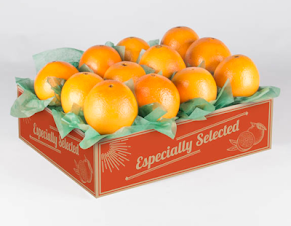Ahhh, spring! Temperatures are warming and the air is pleasant. Here in Florida, we are enjoying bug-free warm days and cool evenings, and a lack of hurricanes. The orange and jasmine blossoms are popping out, wafting sweet scents into the air. Both Easter and Passover are right around the corner, and so are the final weeks of citrus season until the Fall. Here at Florida Fruit Shippers, we wanted to make sure you get the best of the season's final picks for spring: Cara Cara Red Oranges, Navel Oranges, Easy Peel Tangerines, and Ruby Red Grapefruit. It's fruit salad time!
Cara Caras
Want to make your dishes pop with color? The Cara Cara, also known as the Ruby Red or Scarlet Navel Orange, is your citrus of choice. They were first discovered in the 1970's in Venezuela at a place called Hacienda Cara Cara, and are now grown in Florida and California. Their bright red-orange flesh carries notes of strawberry and cranberry, and the extra carotenes that give the pulp such a deep hue carry a whole lot of lycopene, which is a powerful antioxidant. In fact, regular consumption of high-lycopene foods has been shown to help prevent heart disease, prostate cancer, and vision loss. If you "cara cara" about your health, this seedless, easy-to-peel, delicious orange is for you!
Navel Oranges
Navel Oranges have recently been the subject of a study by the University of Florida as research is developed to grow the best, healthiest, and sweetest fruit in their growing regions. It was discovered that the unique sweetness of this fruit is due to the higher organic content of the soil in the navel orange groves of both Florida and California, with the latter oranges having the longest season, through late May. So what is that "navel," anyway? As it turns out, the navel oranges we eat today are exact clones of a single mutated orange that was discovered on a sour orange tree in Brazil by a Presbyterian missionary in the mid nineteenth century. The missionary was so intrigued by this odd and delicious orange with a tiny "baby" orange inside (the navel) that he propagated some little trees from a cutting. Over time, as more and more were propagated throughout growing regions in the Americas, navel oranges became a household standard.
Easy Peel Tangerines
While all citrus fruits are perfect for on-the-go snacking that comes in self-contained packaging, nothing can beat a variety that is easy to peel! It doesn't get easier than our tangerines, whose season continues through May. This particular type of tangerine--the FallGlo--is larger in size than most other varieties, though still identifiable by their distinct tangerine shape. This is because they are actually a genetic cross that is 5/8 tangerine, 1/4 orange, and 1/8 grapefruit! In addition to easy snacking, these tangerines are easy to juice and have a richer flavor than traditional orange juice.
Ruby Red Grapefruits

Nature creates mutations all the time. In the case of citrus, "spontaneous mutations" are particularly common and very natural due to the fragile genomes of these unique fruit types. Lucky for us, some of the yummier and more colorful citrus mutations in our history were discovered and propagated, such as the Navel Orange and the Ruby Red Grapefruit. In the 1800's, yellow and white grapefruits were grown in Florida and Texas, but were considered by most to be too sour. In 1929, a sweet mutation was discovered with red flesh, which was then propagated (via grafting a cutting onto another type of citrus tree) to create a regular supply of the beloved, sweeter Ruby Red Grapefruit that people enjoy regularly today. Best of all, unlike their white counterparts the Ruby Reds have a very high lycopene content and have been shown to help reduce cholesterol levels in humans.
So stock up on your end-of-season citrus and enjoy their health benefits and deliciousness through the spring!
Sources:
https://www.foodnetwork.com/healthyeats/recipes/2013/02/in-season-cara-cara-oranges
https://crec.ifas.ufl.edu/media/crecifasufledu/extension/extension-publications/2021/2021_august_navel.pdf
https://www.npr.org/templates/story/story.php?storyId=103250589
https://edis.ifas.ufl.edu/publication/CH075
https://uscitrus.com/blogs/citrus-delight-blog/mini-history-lesson-how-the-ruby-red-grapefruit-gave-us-the-rio-red

.jpg)






